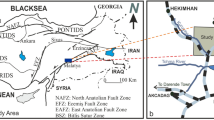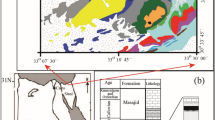Abstract
The Oligocene succession of the Tikak Parbat Formation has prominent coal bearing horizons. The formation comprises of medium to coarse grained light coloured sandstone, clay and carbonaceous shale with four workable coal seams. Core samples from two wells has been studied with regards to organic matter content and type. Relatively high total organic carbon (TOC) contents are present (average 72.103 wt %) in coal; the hydrogen index (HI) values reach a maximum of 410 mg HC/g TOC, indicating presence of type III-II kerogen, and the organic matter is thermally immature (Tmax 428°C) in coal. The genetic potential have maximum yield of 246.53 mg/g, so the coal deposits could act as an excellent source rock for hydrocarbons if the burial depth is sufficient. Carbonaceous shale samples are at early mature stage (Tmax 438°C). Kerogen at this maturity level is within oil window and is capable of generating oil and thermogenic gas upon thermal cracking. The study highlights dense accumulation of reactive macerals (vitrinite + liptinite) and low concentration of inertinite. The empirically derived values for coal reveal a high conversion (>90%) and oil yield (>60%).
Similar content being viewed by others
References
Barker, C. (1974) Pyrolysis techniques for source rock evaluation, AAPG Bull., v.58, pp.2349–2361.
Banik, Prasun (2020) Laboratory investigation of coal characteristics from Tikak Parbat formation of North-East India for coal bed methane study. Jour. Petrol. Explor. Prod. Tech., pp.1–6. DOI: https://doi.org/10.1007/s13202-020-00967-5.
Bezbaruah, D., Muzamil, S. (2013) Deposition history of coal bearing Tikak parbat formation of Barail group in apart of the Belt of Schuppen, Northeast India. South east Asian Jour. Sediment. Basin Res., v.1(1), pp.50–66.
Cudmore, J.F. (1977) Evaluation of coals for conversion to liquid hydrocarbons, In: Coal Borehole Evaluation. Proc. Australasian Inst. Min. Metall., pp. 146–158.
Espitalie, J., Ungerer, P., Irwin, I., Marques, I. (1988) Primary cracking of kerogens. Experimenting and modelling C1, C2–C5, C6–C15 and C15+classes of hydrocarbon formed. Advances in Organic Geochemistry 1987. Org. Geochem., v.13(4–6), pp.893–899.
Evans, P. (1964) The tectonic framework of Assam. Jour. Geol. Soc. India, v.5, pp.80–96.
Fisher, C.H., Sprunk, G.C., Eisner, A., O’Donnell, H.J., Clarke, L., Storch, H.H. (1942) Hydrogeneration and Liquifactionof coal. Part 2, Effect of Petrographic Composition and Rank of Coal. U.S. Bureau of Mines Technical Paper 642, p.151.
Jin J. and Shi S. (1997) The development and prospective application of coal and direct liquefaction for Chinese coals. In: Proceedings of the international symposium on clean coal technology. China Coal Industry Publishing House, Xiamen, p.379.
Gurgey, K. and Bati, Z. (2018) Palynological and petroleum geochemical assessment of the Lower Oligocene Mezardere Formation, Thrace basin, NW Turkey. Turkish Jour. Earth Sci., v.27, pp.349–383. DOI:https://doi.org/10.3906/yer-1710-24.
Guyot, R.E. (1978) Influence of coal characteristics on the yields and properties of hydrogenation products, ACIRL-PR-78–8. Australian Coal Industry Research Laboratories, North Ryde, NSW, Australia.
Langford, F.F., Blanc-Valleron, M.M. (1990) Interpreting Rock-Eval pyrolysis data using graphs of pyrolizable hydrocarbons vs. Total organic carbon. AAPG Bull., v.74(6), pp.799–804.
Lepain, D.L. and Kirkham, R.A. (2015) Rock-eval pyrolysis, vitrinite reflectance and Kerogen microscopy results from Miocene carbonaceous mudstones and coals in outcrop, McGrath Quadrangle, Southwestern Alaska. Report of Investigation 2015–3, State of Alaska, Department of Natural Resources, Division of Geological & Geophysical Surveys.
Majumdar D. and Chetia, B.K. (2015) Source rock evaluation of petm generated disang shales occurring in parts of Arunachal Pradesh, NE India. Jour. Appl. Geochem., v. 7(1), pp.1–9.
Mendhe, V.A., Mishra, S., Varma, A.K., Kamble, A.K., Bannerjee, M., Singh, B.D., Sutay, T.M., Singh, V.P. (2018) Geochemical and petrophysical characteristics of Permian shale gas reservoirs of Raniganj Basin, West Bengal, India. Internat. Jour. Coal Geol., v.188, pp.1–24. DOI:https://doi.org/10.1016/j.coal.2018.01.012.
Nady, M.M.E. and Hammad, M.M. (2015) Organic richness, Kerogen types and maturity in the shales of the dakhla and Duwi formations in Abu Tartur area, Western Desert, Egypt: Implication of Rock-Eval pyrolysis. Egyptian Jour. Petrol. DOI:https://doi.org/10.1016/j.ejpe.2015.10.003.
Nunez-Betelu, L. and Baceta, J. I. (1994) Basics and application of rock-eval/TOC pyrolysis: an example from the uppermost Paleocene/lowermost Eocene in the Basque Basin, Western Pyrenees. Munibe(Ciencias Naturales- natur Zientziak), No 46, pp. 43062, San sabastia.
Pandey, B., Pathak, D.B., Mathur, N., Jaitly, A.K., Singh, A.K., and Singh, P.K. (2018) A preliminary evaluation on the prospects of hydrocarbon potential in the carbonaceous shales of Spiti and Chikkim Formations, Tethys Himalaya, India. Jour. Geol. Soc. India, v.92, pp.427–43
Panwar, D.S., Saxena, V.K., Rani, A., Singh, A.K. and Kumar, V. (2017) Source rock evaluation of the Gondwana coals in Raniganj coalfield, India. Energy Sources, Part A: Recovery, Utilization, and Environmental effects, v.39(13), pp.1395–1402. DOI:https://doi.org/10.1080/15567036.2017.1334105.
Peters, K.E. and Simoneit, B.R.T. (1982) Microscopic, elemental analysis, total organic carbon and Rock Eval Pyrolysis at DSDP Holes 64–479 and 64–480. Pangaea. DOI:https://doi.org/10.1594/PANGAEA.819032.
Price, L.C., Pawlewicz, M. and Daws, T. (1999) Organic Metamorphism in the California Petroleum Basins. Chapter A- Rock-Eval and Vitrinite Reflectance. USGS Bull., 2174-A.
Rock-Eval Pyrolysis. (2020) Chapter 5 http://www.shodhganga.inflibnet.ac.in>jspui>bitstream (accessed 18 March 2020).
Sarmah, R.K. (2013) Study of the macerals Composition and coal facies of the Oligicene coal in makum coalfields, Upper Assam, India. Indian Jour. Appl. Res., v.3, pp.281–285.
Sebag, D., Disnar, J.R., Guillet, B., Di Giovanni, C., Verrecchia, E.P., Durand, A. (2006) Monitoring organic matter dynamics in soil profiles by “Rock-Eval pyrolysis”: bulk characterization and quantification of degradation. European Jour. Soil Sci., v.57(3), pp.344–355.
Singh, M.P. and Singh, G.P. (1993) Rock-Eval Pyrolysis study of Paleogene coals of Jammu, J& K. Proc. Indian Nat. Sci. Acad., v.59, A, No.4, pp.359–366.
Singh, M.P. and Singh, P.K. (1994) Indications of Hydrocarbon generation in the coal deposits of the Rajmahal basin, Bihar: Revelation of Fluorescence microscopy. Jour. Geol. Soc. India, v.43(6), pp.647–658.
Singh, Prakash K., Singh V. K., Rajak, P. K., and Mathur, N. (2017) A study on assessment of hydrocarbon potential of the lignite deposits of Saurashtra basin, Gujarat (Western India). Internat. Jour. Coal Sci. Tech., v. 4(4), pp.310–321.
Singh, V. P., Singh, B.D., Mathews, R.P., Singh, A., Mendhe, V.A., Singh, P.K., Mishra, S., Dutta, S., Mahesh Shivanna, M., and Singh, M.P. (2017) Investigation on the lignite deposits of Surkha mine (Saurashtra Basin, Gujarat), western India: their depositional history and hydrocarbon generation potential. Internat. Jour. Coal. Geol., v.183, pp.78–99.
Singh, P.K., Singh, V. K., Rajak, P., K., Singh, M. P., Nail, A.S., Raju, S.V. and Mohanty, D. (2016) Eocene lignites from Cambey basin, Western India: An excellent source of hydrocarbon. Geoscience Frontiers v.7, pp.811–819. DOI:https://doi.org/10.1016/j.gsf.2015.08.001.
Sykes, R and Snowdon, L.R. (2002) Guidelines for Assessing the Petroleum Potential of Coaly Source Rocks using Rock-Eval Pyrolysis, Organic Geochemistry, v.33, pp.1441–1455. DOI:https://doi.org/10.1016/S0146-6380(02)00183-3.
Tulan, E., Sachsenhofer, R.F., Tari, G., Flecker, R., Fairbank, V., Pupp, M., Ickert, R.B. (2020) Source rock potential and depositional environment of the Lower Oligocene Ihsaniye Formation in NW Turkey (Thrace, Karaburun). Turkish Jour. Earth Sci., v.29, pp.64–84. DOI:https://doi.org/10.3906/yer-1906-14.
Varma, A.K., Hazra, B., Mendhe, V.A., Chinara, I. and Dayal, A.M. (2015) Assessment of organic richness and hydrocarbon generation potential of Raniganj basin shales, West Bengal, India. Marine Petrol. Geol., v.59, pp.480–490. DOI: https://doi.org/10.1016/j.marpetgeo.2014.10.003.
Acknowledgement
Authors thank the Head, CGM (Chem.), Regional Geoscience Labs., Oil and Natural gas Corporation Limited, Sivasagar, India for helping us in analysis of Rock Eval Pyrolysis and TOC of the studied samples. The authors are indebted to the Project Head, Dart Energy and Head, CBM Project, OIL for providing core samples. We are also grateful to AICTE, India for funding under RPS-NER project of “To study the coal characteristics of north-eastern coals for estimation of gas content within coal seams and storage capacity of coal.”
Author information
Authors and Affiliations
Rights and permissions
About this article
Cite this article
Banik, P., Phukan, S. & Das, M. Hydrocarbon Source Potential of Coal-bearing Tikak-Parbat Formation of Barail Group in a Part of the Belt of Schuppen, India. J Geol Soc India 97, 767–771 (2021). https://doi.org/10.1007/s12594-021-1758-3
Received:
Accepted:
Published:
Issue Date:
DOI: https://doi.org/10.1007/s12594-021-1758-3




